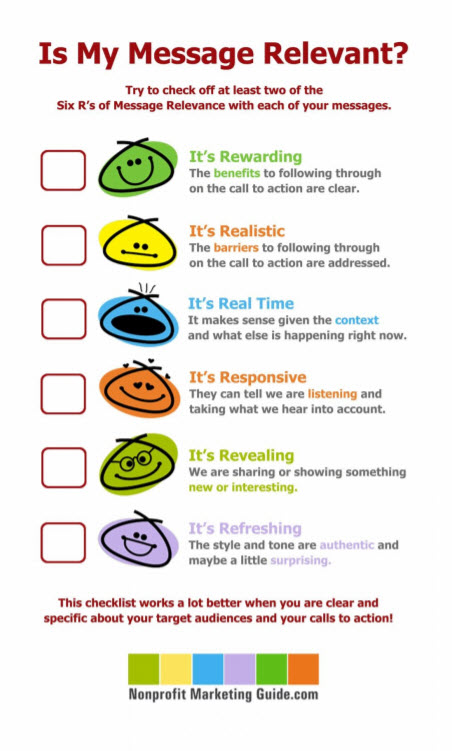Nonprofit communicators are full of anxiety right now about messaging, from what to say, to how often, and where to say it.
Let’s get two common questions out the way . . .
Should we stop messaging if our work has nothing to do with coronavirus? No, you should keep talking about what you know best and what your supporters still care about too, even if it’s not necessarily top of mind right now. This includes fundraising appeals. You may want to tweak the tone of your messaging, which I discuss below.
Should we try to bridge discussions of our work to connect to coronavirus? Maybe. It really depends on what you do. If it’s a small leap, because the people you serve are definitely impacted by either the virus itself or all the various closures, then it’s entirely appropriate. It’s the context that the entire world is working in right now. However, if you’d be connecting a lot of dots to get there, then no. Just stick to your regular messaging with some suggested tweaks below.
OK, so how can we communicate in a relevant way? What are these messaging tweaks?
Follow our tried-and-true 6 Rules of Message Relevance (PDF of the graphic below) which are found in my Content Marketing for Nonprofits book. Try to make sure your messaging addresses at least one and hopefully two or even three of the six Rs. If you can’t even hit one of these solidly, your message is not relevant and is a waste of everyone’s time, including your own.

Think about what the people on your lists (email, direct mail, social, etc.) are going through right now. Why do they care about your issues in the first place? What’s your relationship with them? Given this context, would they consider the messaging you are drafting to be rewarding, realistic, real-time, responsive, revealing, and/or refreshing?
Would it make sense, for example, to send a message that says, “We are here for you. Please let us know how we can help you.” Or “Please take this survey so we can better understand your needs right now.”
Let’s Apply the Six Rs and See If This Works
Is this rewarding? No. It would be rewarding to you if people did it. But it’s clearly self-centered, even if it appears to be about the people you are sending it to. What’s in it for them? Not much.
Is it realistic? Doubtful. Yes, there are some people who are home alone bored stiff. But most people of workforce age are juggling A LOT right now with family schedules thrown out the window, paychecks disappearing into thin air, and anxiety about how long this will all last. They don’t have a lot of time to even think through their own needs, let alone articulate them to you.
Is it real-time? Maybe, but doubtful. A quick one or two question poll would work better, especially one that allows people to see the responses of others in real-time (after they take it themselves is fine).
Is it responsive? Hell no! You should have been listening and surveying before so you know how to respond now. Yes, this is unprecedented and unpredictable. I get that you may feel at a loss. But the whole point is that you should already have a general clue about what your community needs from you, and use your communications to refine that now, not to start from scratch.
Is it revealing? No. It’s only revealing that you don’t know what you are doing.
Is it refreshing? Seriously? No. Have you seen how many companies and organizations are using nearly identical generic messaging like this?
In many ways, this is analogous to the advice about what to say and not to someone who is grieving the loss of a loved one (because we are all grieving the loss of life as we know it, for who knows how long). See what I mean here and here.
Still at a Loss?
Take some initiative. Put some stuff out there. See if people respond or not. Ask SIMPLE and FAST questions to help you refine.
Get into thoughtful conversations with people that allow you to genuinely connect and discuss what’s happening. Listen, listen, listen.
Spread joy. Give hope. Help people visualize a happier and healthier future on the other side of this pandemic.
That’s what will give you the additional insights you need to move forward.
But stop asking us to do your homework for you. We have enough of that with the sudden homeschooling of our kids.
Will you find occasions in our own messaging from Nonprofit Marketing Guide where we ask you, in a very open-ended way, what you need? Of course, you will. I am not suggesting that you banish this language from your vocabulary. But that’s not the driving force behind our messaging, as if we are sitting back and waiting for everyone else to tell us what our jobs are.
And it shouldn’t be your primary messaging either.





